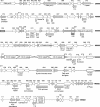Genomic sequence of Spodoptera frugiperda Ascovirus 1a, an enveloped, double-stranded DNA insect virus that manipulates apoptosis for viral reproduction
- PMID: 16987980
- PMCID: PMC1642580
- DOI: 10.1128/JVI.01639-06
Genomic sequence of Spodoptera frugiperda Ascovirus 1a, an enveloped, double-stranded DNA insect virus that manipulates apoptosis for viral reproduction
Abstract
Ascoviruses (family Ascoviridae) are double-stranded DNA viruses with circular genomes that attack lepidopterans, where they produce large, enveloped virions, 150 by 400 nm, and cause a chronic, fatal disease with a cytopathology resembling that of apoptosis. After infection, host cell DNA is degraded, the nucleus fragments, and the cell then cleaves into large virion-containing vesicles. These vesicles and virions circulate in the hemolymph, where they are acquired by parasitic wasps during oviposition and subsequently transmitted to new hosts. To develop a better understanding of ascovirus biology, we sequenced the genome of the type species Spodoptera frugiperda ascovirus 1a (SfAV-1a). The genome consisted of 156,922 bp, with a G+C ratio of 49.2%, and contained 123 putative open reading frames coding for a variety of enzymes and virion structural proteins, of which tentative functions were assigned to 44. Among the most interesting enzymes, due to their potential role in apoptosis and viral vesicle formation, were a caspase, a cathepsin B, several kinases, E3 ubiquitin ligases, and especially several enzymes involved in lipid metabolism, including a fatty acid elongase, a sphingomyelinase, a phosphate acyltransferase, and a patatin-like phospholipase. Comparison of SfAV-1a proteins with those of other viruses showed that 10% were orthologs of Chilo iridescent virus proteins, the highest correspondence with any virus, providing further evidence that ascoviruses evolved from a lepidopteran iridovirus. The SfAV-1a genome sequence will facilitate the determination of how ascoviruses manipulate apoptosis to generate the novel virion-containing vesicles characteristic of these viruses and enable study of their origin and evolution.
Figures


References
-
- Agarwal, A. K., R. A. Barnes, and A. Garg. 2006. Functional characterization of human 1-acylglycerol-3-phosphate acyltransferase isoform 8: cloning, tissue distribution, gene structure, and enzyme activity. Arch. Biochem. Biophys. 449:64-76. - PubMed
-
- Ahmad, S. I., S. H. Kirk, and A. Eisenstark. 1998. Thymine metabolism and thymineless death in prokaryotes and eurkaryotes. Annu. Rev. Microbiol. 52:591-625. - PubMed
-
- Andrieu-Abadie, N., and T. Lavade. 2002. Sphingomyelin hydrolysis during apoptosis. Biochim. Biophys. Acta 1585:126-134. - PubMed
-
- Aravind, L., and E. V. Koonin. 2001. A natural classification of ribonucleases. Methods Enzymol. 341:3-28. - PubMed
Publication types
MeSH terms
Substances
Associated data
- Actions
LinkOut - more resources
Full Text Sources

